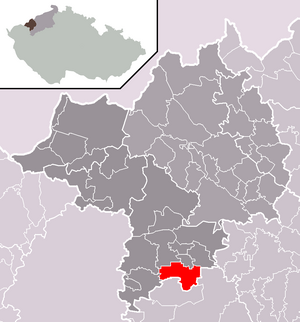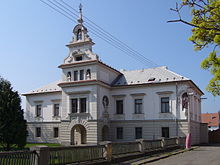Veliká Ves
| Veliká Ves | ||||
|---|---|---|---|---|
|
||||
| Basic data | ||||
| State : |
|
|||
| Region : | Ústecký kraj | |||
| District : | Chomutov | |||
| Area : | 1781.326 ha | |||
| Geographic location : | 50 ° 16 ' N , 13 ° 22' E | |||
| Height: | 275 m nm | |||
| Residents : | 304 (Jan. 1, 2019) | |||
| Postal code : | 430 03 - 441 01 | |||
| License plate : | U | |||
| traffic | ||||
| Street: | Pětipsy - Krásný Dvůr | |||
| Railway connection: | Kaštice – Kadaň | |||
| structure | ||||
| Status: | local community | |||
| Districts: | 5 | |||
| administration | ||||
| Mayor : | Miroslav Ogáseanu (Status: 2018) | |||
| Address: | Podlesice 53 441 01 Podbořany |
|||
| Municipality number: | 563412 | |||
| Website : | www.velikaves.cz | |||
| Location of Veliká Ves in the Chomutov district | ||||

|
||||
Veliká Ves (German Michelsdorf ) is a municipality in the Czech Republic . It is located six kilometers north of Podbořany and belongs to the Okres Chomutov .
geography
Geographical location
Veliká Ves is located east of the Duppau Mountains on the Dubá brook in the North Bohemian Basin . The Rubín (352 m), Rudnice (371 m) and Podbořanský vrch (328 m) rise to the south-east and the Kozel ( Boxberg , 364 m) in the south-west . In the south and west, the town is bypassed by the Kaštice – Kadaň railway line .
Community structure
The municipality of Veliká Ves consists of the districts Nové Třebčice ( German Trebetitsch ), Podlesice ( Podletitz ), Široké Třebčice ( Weitentrebetitsch ), Veliká Ves ( Michelsdorf ) and Vitčice ( Groß Witschitz ).
Neighboring communities
Neighboring towns are Račetice in the north, Široké Třebčice and Mory in the northeast, Oploty, Neprobylice and Kaštice in the east, Zlovědice and Vysoké Třebušice in the southeast, Krásný Dvůr in the south, Chrašťany in the southwest, Chotěbudice in the west and Podlesice, Vitčebice and in the north.
history
Magna villa was first mentioned in a document in 1369. The place was built around a fortress and has been a parish village since the 14th century. The owners of the village were the Škopek of Dubá at the end of the 14th century . After 1400 the St. Vitus Chapter acquired the goods and leased them to Nikolaus von Slupno. At that time hops were already being grown. Over time, the village was referred to as Welikau Wsy , Welkau Wes and Michelsdorf . In 1414 Nikolaus Lobkowitz von Hassenstein bought the goods and added them to his rule Hassenstein . After the death of his grandson Jaroslav Lobkowitz, his three sons shared the rule in 1490. The owner of Welikau Wsy became Jan Lobkowitz, whom his son Jaroslav inherited in 1529. In 1561 Count Schlick bought the place. In 1562 Johann Waldemar Lobkowitz von Hassenstein became the owner of the goods and added them to the Mašťov rule . The son Bohuslav Felix von Lobkowitz and Hassensteins was a staunch opponent of Catholicism and did not tolerate Catholic pastors in his rule. In 1603 Prokop Dvořečký von Olbramowitz bought Mašťov from the brothers Johann Bartholomäus and Georg Ctirad von Schwanberg , Johann Waldemars grandsons . In 1612 it was sold to Matthias d. Ä. from Steinbach . Johann Heinrich von Steinbach lost his property as a close follower of Frederick V after the battle of the White Mountain . In 1623 the rule of Maschau was sold to the Spanish general Wilhelm Verdugo de la Scala († 1629), who was raised to the rank of imperial count and baron of Maschau and Duppau . After the Thirty Years' War, the Augustinian monastery in Prague's Karlshof acquired Michelsdorf. In the Berní rula of 1654, 23 properties are identified for the village, four of which were in desolation. In addition to the Augustinians, the Groschau (Chrašťany) estate owned a small portion of Michelsdorf at that time. The order had the old castle demolished and a new baroque building erected, which served as the abbot's summer residence. Abbot Tomáš Josef Girčan died in the castle.
After the monastery was withdrawn, Michelsdorf became part of the religious fund in 1785 and was sold to Ignaz Schreiter three years later. The place consisted of 38 houses at that time. Mining on brown coal began at the end of the 18th century. In 1811 Ignaz Schreiter had the Ignazschacht lignite mine built. Because of his merits in the Napoleonic Wars, Ignaz Schreiter jun. In 1816 he was knighted and was given the title Schreitter von Schwarzenfeld.
After the abolition of patrimonial Michelsdorf / Veliká Ves formed a community in the Podersam district from 1850 . At that time, Franz Seidl's fruit nursery was successfully breeding silkworms on mulberry trees. In 1866 cholera broke out, from which the tree nursery owner Seidl also died. Other mines that emerged in the second half of the 19th century were the Michael Schacht, the Ambrosius Schacht and the Barbara Schacht. In 1890 the Schreitter family sold the castle to Richard Procházka from Prague, and in 1896 Jaroslav Kose bought it. In 1900 the village had 300 inhabitants. At that time agriculture was already outweighing mining. In 1920 Josef Zahn bought the castle. In 1926, lignite mining was completely stopped. In 1930 there were 219 people in Michelsdorf.
After the Munich Agreement , the place was added to the German Reich in 1938 and belonged to the Podersam district until 1945 . In 1939 the village had 198 inhabitants. After the end of World War II, Veliká Ves returned to Czechoslovakia and the German population was expelled .
In 1949 the chateau was handed over to the administration of the Krásný Dvůr State Estate .
At the beginning of 1961 the community came to Okres Chomutov and at the same time Vitčice, Nové Třebčice, Široké Třebčice and Podlesice were incorporated. The baroque castle in Široké Třebčice was demolished in 1988.
Culture and sights
- Veliká Ves Castle, the Baroque castle completed in 1762, served as the abbots' summer residence until 1785. Between 1890 and 1896, Richard Procházka was rebuilt in neo-Renaissance style
- Church of St. James the Elder, built in 1764 instead of a previous building that had burned down
- Bell tower in front of the church on the village square, built in the 16th century
- baroque statues of St. Augustin and Johann von Nepomuk in front of the main entrance of the church, created in 1773
- Statue of St. Guardian angel from the end of the 18th century in the village square
- Jewish quarter in Široké Třebčice, the settlement consisting of seven row houses was built between 1709 and 1722 on the initiative of Franz Joseph von Schönkirchen
- Church of the Exaltation of St. Cross in Široké Třebčice, the baroque building built in 1822 instead of a chapel from 1722 is in a dilapidated state
Personalities
Sons and daughters of the church
- Anton August Naaf (1850–1918), Austrian journalist and writer, born in Weitentrebetitsch
- Franz Stöhr (1879–1938), National Socialist politician, born in Weitentrebetitsch
Lived and worked in the community
- Matthias von Janow (between 1350 and 1355-1393), the Prague reform theologian, was transferred to Michelsdorf in 1388 and wrote his main work Regulae Veteris et Novi Testamenti here



